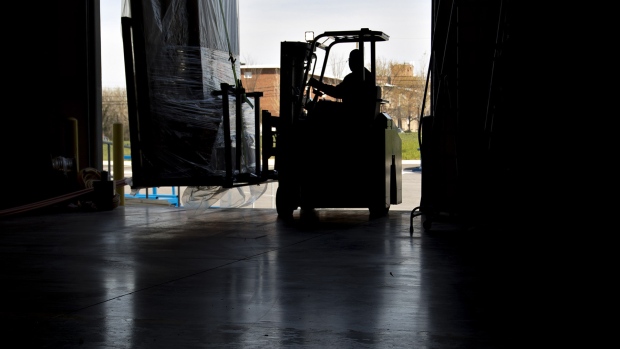Feb 28, 2019
U.S. GDP grows above-forecast 2.6% as business spending picks up
, Bloomberg News

The U.S. economy cooled by less than expected last quarter as business investment picked up, suggesting growth could be stronger for longer as the Federal Reserve takes a patient approach to interest rates.
The 2.6 per cent annualized rate of gains in gross domestic product from October to December compared with the 2.2 per cent median estimate of economists surveyed by Bloomberg. It followed a 3.4 per cent advance in the prior three months, according to a Commerce Department report Thursday that was delayed a month by the government shutdown.
Consumption, which accounts for the majority of the economy, grew 2.8 per cent, slightly below forecasts, while nonresidential business investment accelerated to a 6.2 per cent gain on equipment, software and research spending. Government spending slowed, trade was a minor drag and inventories gave GDP a small boost.
The report shows how Republican-backed tax cuts may have continued to aid growth and help bring the full-year figure to 3.1 per cent, just above President Donald Trump’s 3 per cent goal. While the expansion is poised to become the nation's longest on record at midyear amid a still-healthy consumer, supportive Fed and robust labor market, the pace could cool amid the trade war, slowing global growth and fading impact of fiscal stimulus.
A separate report Thursday from the Labor Department showed filings for unemployment benefits rose by more than expected last week to 225,000, still near a five-decade low. The week included the Presidents Day holiday, and claims tend to be more volatile around such events.
Potential Growth
Growth, while slower than the prior two quarters, remains above both the average pace of the expansion and what the Fed sees as the economy's long-run potential of 1.9 per cent. Still, surveys and gauges such as Treasury yields indicate chances of a recession have increased in recent months while remaining unlikely for 2019.
Excluding the volatile trade and inventories components of GDP, final sales to domestic purchasers increased at a 2.6 per cent pace following 2.9 per cent. Economists monitor this measure for a better sense of underlying demand.
The increase in consumer spending followed the third quarter's 3.5 percent gain. It contributed 1.92 percentage points to growth. Drivers included health care, financial services and insurance, and other nondurable goods and services, while spending on food services and accommodations fell.
The GDP data may reinforce analyst criticism of the government's recent report on December retail sales. That showed the biggest drop in nine years, even as other figures -- particularly reports from the country’s largest retailers -- indicated consumers continued to open their wallets in the quarter.
Thursday's report showed the third-quarter slowdown in business spending may have been temporary. Nonresidential fixed investment contributed 0.82 percentage point to growth following 0.35 point in the third quarter.
Within that category, spending on structures fell 4.2 percent, the biggest drop in a year, a slowdown that may partly reflect falling oil prices. Business-equipment investment rose 6.7 percent and intellectual property spending jumped 13.1 percent.
Residential Drag
Housing remained a weak spot last quarter, posting the fourth consecutive drag on GDP growth, with a contraction of 3.5 percent. Home sales tumbled in late 2018 amid elevated mortgage rates and price increases that continued to outpace wages, though there are signs of demand picking up in early 2019 thanks to a drop in borrowing costs.
Net exports subtracted 0.22 percentage point from GDP growth during the quarter following a 1.99-point reduction in the prior period. The drag reflected a 2.7 percent rise in imports that outpaced a 1.6 per cent increase in exports, with the tariff war buffeting both sets of flows.
Inventories added 0.13 percentage point to the pace of expansion.
Meanwhile, inflation remained muted, adding little urgency for the Fed to consider resuming interest-rate hikes. The GDP report showed the Fed's preferred price index rose at a 1.5 percent annualized pace last quarter, below the central bank's 2 per cent goal. Excluding food and energy, the index rose 1.7 percent.
Get More
- Government spending increased at a 0.4 per cent rate, reflecting a 6.9 per cent jump in defense spending -- the most in nine years -- and a 5.6 per cent contraction in non-defense spending, the biggest drop since 2013.
- The savings rate rose to 6.7 per cent from 6.4 per cent in the prior quarter, as inflation-adjusted disposable income rose 4.2 per cent, the most in three quarters.
- The partial shutdown, which began Dec. 22, had the effect of lowering fourth-quarter GDP growth by about 0.1 percentage point when accounting for the impact of reductions in services provided by the federal government, though the Commerce Department cautioned that the full effects of the shutdown on the economy can't be quantified.
- The first GDP estimate was originally scheduled for release Jan. 30. Thursday's report encompasses both advance and second estimates. The revised estimate of fourth-quarter GDP is due March 28, data which will also include corporate profits for the period.